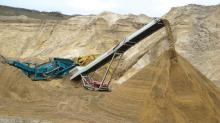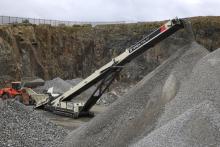
Conveyors have always played a key role in quarry operations but new developments are improving their potential to boost productivity
High fuel costs were driving more quarries to consider conveyors as an alternative hauling option in many quarries in Europe. But conveyors can also offer benefits when it comes to stockpiling and the latest developments have extended the advantages to mobile machines.
Ireland-based
"The new conveyors are the first of their kind in the industry and offer the ability to produce large capacity stockpiles from mobile crushing and screening equipment," said Telestack director Malachy Gribben. "Being able to stockpile more material means that quarry operators do not need to have a wheeled loader continually working to re-handle the aggregates. The cost difference can be huge - typical owning, operating and maintaining costs for a wheeled loader can be €65 per hour but for these new conveyors, it's about €20 per hour." The unit being used at the Swedish quarry has a conveyor length of 21m with a discharge height of 10m with a capacity to handle up to 600tonnes per hour to create a maximum stockpile size of 2820tonnes. The conveyor comes with a diesel hydraulic drive as standard but the unit supplied to the Swedish quarry has been fitted with an electric drive to fit with its existing machine fleet and on site services.
According to Gribben, other benefits of the TC-range conveyors mean that the material remains within specification and safety on the site is also improved as there is less traffic. "For a wheeled loader to produce the same size of stockpile, the operator has to drive up on the pile," explained Gribben. "This not only causes compaction of the graded materials but also has safety implications too. For neighbours near the site, the conveyor also produces less noise."
Dust management
Minimising noise is one benefit of conveyors but some designs do add the potential for creation of dust and this is something that
Belt technology
According to
"There are new products that have been developed to offer a longer service life and reduce the potential for down time," he said. "Materials like
"OEMs such as
Rapid repair
When it comes to replacing conveyor belts there are three options - cold vulcanisation, hot vulcanisation and mechanical fasteners. Hot techniques required expensive equipment and skilled operatives and mechanical fasteners create the risk of belts not tracking straight and loss of metal items into the feed material.
Cold vulcanisation offers the best approach for fast on site repairs and to ensure repairs are carried out to a high standard, Sandvik has now developed a kit to give operatives on site all the necessary equipment along with easy to follow instructions.
According to Sandvik, the kit has been tested by a number of its dealers and repaired conveyor belts have been put through their paces in a number of challenging operations from crushers through to scalping screens.
Sandvik global service manager Conor McAleer said, "The technique has been used for 25 years by our Australian dealer but the kit will bring the benefits to a wider number of quarries. Initial interest has been strong in remotely located quarries - we have sold nine to Angola already." Instructions for the kit are to be translated into French, German, Spanish and Italian.








